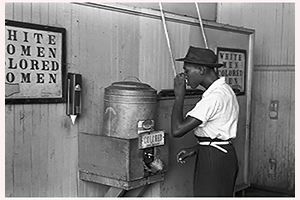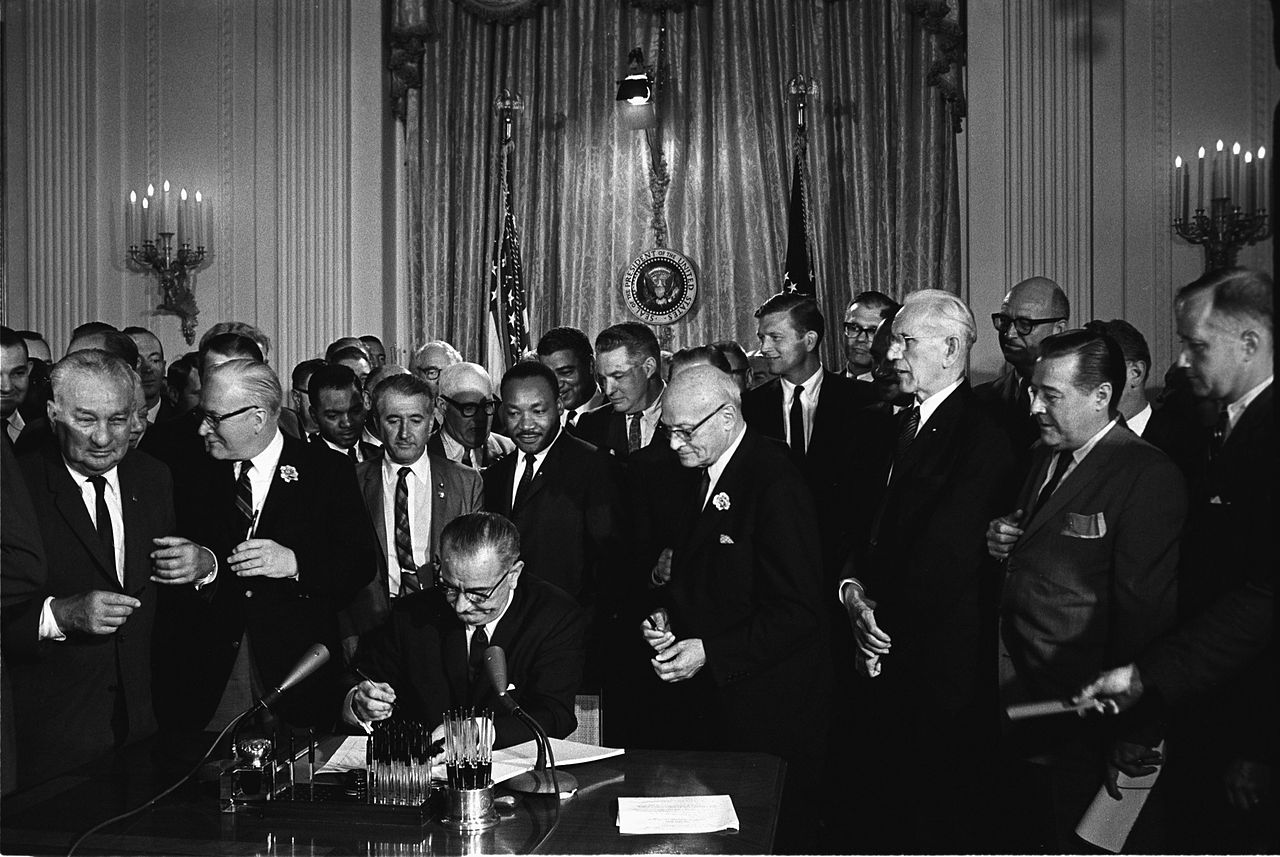
- Pictured: An African American man drinks from a water cooler in 1939. Photo by Russell Lee, United States Library of Congress.
East Texas Hot Links takes place in the early summer of 1955 “in the Piney Woods” of an unspecified area somewhere roughly halfway between Houston and Dallas. Ninety years after the conclusion of the Civil War, black Americans were still harshly marginalized and legally discriminated against. Although the Civil Rights movement would begin in earnest later that year, the regulars at the Top o’ the Hill Cafe depicted in the play still live in a world of ever-present racial hatred and under the threat of violence.
Following the 1896 Supreme Court ruling in Plessy v. Ferguson, “separate but equal” had become a constitutional reality in the United States, and Texas was no exception. Separate washrooms, separate seating on buses, separate rail cars, separate libraries, separate waiting areas: all were legal in the Lone Star State. Actions beyond the scope of the law were, horrifically, also commonplace. “In the 1880s, white men in East Texas used violence as a method of political control, and lynching became the common form of retaliation for alleged rapes of white women or for other insults or injuries perpetrated upon white society,” according to the Texas State Historical Association. “The Ku Klux Klan, the White Caps, law officials, and the Texas Rangers, all acting as agents of white authority, regularly terrorized both Mexican Americans and black Texans.” An article in the East Texas Historical Journal states “approximately 340 African Americans were lynched in Texas from 1885 to 1942. Northeast Texas was one of the most lawless and lynching-prone areas in the state.”
There was no political recourse to be had against this injustice. “By the late 1920s, Texas politicians had effectively immobilized African-Texan voters through court cases that defined political parties as private organizations that could exclude members. Some scholars have estimated that no more than 40,000 of the estimated 160,000 eligible black voters retained their franchise in the 1920s.”
Midway through the 20th century, there were rumblings of change. 1.2 million black Americans were serving in the armed forces at the end of the Second World War. In 1948, President Truman officially ended segregation in the military. The first big change on the domestic front arrived in 1954, when a case brought before the United States Supreme Court would overturn 60 years of Jim Crow laws. In Brown v. Board of Education, the Court stated “separate educational facilities are inherently unequal” and de jure segregation was ruled a violation of the Equal Protection Clause of the Fourteenth Amendment of the United States Constitution. Schools would be forced to integrate their students.
One early attempt at school integration occurred just outside Dallas in 1955. Brian Behnken, author of Fighting Their Own Battles, explains: “In Mansfield, a group of African American parents represented by the National Association for the Advancement of Colored People (NAACP) sought the admission of three black teenagers to the white high school. The school’s superintendent denied the request. When the NAACP filed suit, the district court ruled for the school district. The Fifth Circuit Court of Appeals in New Orleans […] reversed the district court and […] ordered the superintendent to integrate the town’s high school. In response, a mob of segregationists—four hundred strong—marched on the school and prevented the students from enrolling, hung several effigies of African Americans, and threatened to kill NAACP leaders and destroy the black section of town. Fearing the crowd, blacks bought guns and guarded the homes of
important NAACP officials. Governor Alan Shivers ultimately sent in the Texas Rangers to defend the segregated system. When President Dwight D. Eisenhower declined to intercede, the district returned to the status quo. Thus Texas’s version of the Little Rock crisis, which occurred two years later, passed into history.”
 Pictured: President Lyndon B. Johnson signs the 1964 Civil Rights Act as Martin Luther King, Jr. and other leaders look on. Photo by Cecil Stoughton, White House Press Office.
Pictured: President Lyndon B. Johnson signs the 1964 Civil Rights Act as Martin Luther King, Jr. and other leaders look on. Photo by Cecil Stoughton, White House Press Office.
On December 1, 1955, months after the fictionalized events of East Texas Hot Links, Rosa Parks was arrested for refusing to give up her seat on a bus in Montgomery, Alabama. In response, a local minister named Martin Luther King, Jr. helped organize a boycott of the bus system by the black community that lasted for 381 days. On June 4, 1956, the federal district court ruled that the Alabama laws were unconstitutional, a decision the Supreme Court upheld in November. King immediately became the leader of a new movement towards equality for black and other marginalized peoples, joining with some of the other ministers who participated in the boycott to soon form the Southern Christian Leadership Conference.
This very early stage of the Civil Rights movement is the backdrop against which East Texas Hot Links is set, but its relevance transcends that setting. Even though President Johnson signed the Civil Rights Act into law in 1964, the movement for racial equality is not over. Just last year, the questionable arrest and subsequent suicide of Sandra Bland, a black woman, took place outside Houston. The troubled history between African Americans and white authority in East Texas and elsewhere continues.


No comments yet.